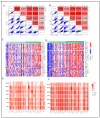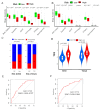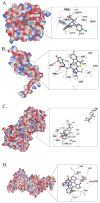Identification of Cancer Associated Fibroblasts Related Genes Signature to Facilitate Improved Prediction of Prognosis and Responses to Therapy in Patients with Pancreatic Cancer
- PMID: 40430018
- PMCID: PMC12112120
- DOI: 10.3390/ijms26104876
Identification of Cancer Associated Fibroblasts Related Genes Signature to Facilitate Improved Prediction of Prognosis and Responses to Therapy in Patients with Pancreatic Cancer
Abstract
Pancreatic cancer (PC) is highly aggressive, with a 5-year survival rate of 12.8%, making early detection vital. However, non-specific symptoms and precursor lesions complicate diagnosis. Existing tools for the early detection of PC are limited. CAFs are crucial in cancer progression, invasion, and metastasis, yet their role in PC is poorly understood. This study analyzes mRNA data from PC samples to identify CAF-related genes and drugs for PC treatment using algorithms like EPIC, xCell, MCP-counter, and TIDE to quantify CAF infiltration. Weighted gene co-expression network analysis (WGCNA) identified 26 hub genes. Our analyses revealed eight prognostic genes, leading to establishing a six-gene model for assessing prognosis. Correlation analysis showed that the CAF risk score correlates with CAF infiltration and related markers. We also identified six potential drugs, observing significant differences between high-CAF and low-CAF risk groups. High CAF risk scores were associated with lower responses to immunotherapy and higher tumor mutation burdens. GSEA indicated that these scores are enriched in tumor microenvironment pathways. In summary, these six model genes can predict overall survival and responses to chemotherapy and immunotherapy for pancreatic cancer, offering valuable insights for future clinical strategies.
Keywords: WGCNA; cancer associated fibroblast; chemotherapy; immunotherapy; molecular docking; pancreatic cancer; prognosis.
Conflict of interest statement
The authors declare no conflicts of interest.
Figures








Similar articles
-
Predicting Prognosis and Immunotherapy Response in Glioblastoma (GBM) With a 5-Gene CAF-Risk Signature.Cancer Rep (Hoboken). 2025 Apr;8(4):e70158. doi: 10.1002/cnr2.70158. Cancer Rep (Hoboken). 2025. PMID: 40226936 Free PMC article.
-
A Novel Molecular Signature of Cancer-Associated Fibroblasts Predicts Prognosis and Immunotherapy Response in Pancreatic Cancer.Int J Mol Sci. 2022 Dec 21;24(1):156. doi: 10.3390/ijms24010156. Int J Mol Sci. 2022. PMID: 36613599 Free PMC article.
-
Heterogenous cancer-associated fibroblasts related tumor microenvironment marked by CD10/KLF4/TIAM1 were identified in pancreatic adenocarcinoma by integrated transcriptomics.Front Immunol. 2025 Apr 14;16:1557698. doi: 10.3389/fimmu.2025.1557698. eCollection 2025. Front Immunol. 2025. PMID: 40303408 Free PMC article.
-
A Novel Pancreatic Cancer Hypoxia Status Related Gene Signature for Prognosis and Therapeutic Responses.Mol Biotechnol. 2024 Jul;66(7):1684-1703. doi: 10.1007/s12033-023-00807-x. Epub 2023 Jul 5. Mol Biotechnol. 2024. PMID: 37405638 Review.
-
Recent advances in understanding cancer-associated fibroblasts in pancreatic cancer.Am J Physiol Cell Physiol. 2020 Aug 1;319(2):C233-C243. doi: 10.1152/ajpcell.00079.2020. Epub 2020 May 20. Am J Physiol Cell Physiol. 2020. PMID: 32432930 Free PMC article. Review.
Cited by
-
Paracrine signaling in cancer-associated fibroblasts: central regulators of the tumor immune microenvironment.J Transl Med. 2025 Jun 23;23(1):697. doi: 10.1186/s12967-025-06744-4. J Transl Med. 2025. PMID: 40551209 Free PMC article. Review.
References
-
- Liot S., Balas J., Aubert A., Prigent L., Mercier-Gouy P., Verrier B., Bertolino P., Hennino A., Valcourt U., Lambert E. Stroma Involvement in Pancreatic Ductal Adenocarcinoma: An Overview Focusing on Extracellular Matrix Proteins. Front. Immunol. 2021;12:612271. doi: 10.3389/fimmu.2021.612271. - DOI - PMC - PubMed
MeSH terms
Substances
LinkOut - more resources
Full Text Sources
Medical
Miscellaneous

